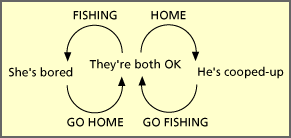Below is a list of speech acts that have been researched at CARLA. Within each category you will find basic information about the speech act, as well as teaching tips, sample exercises, and past research findings.
Apologies
Complaints
Compliments/Responses
Refusals
Requests
Thanks
American Apologies
In American English people typically use apologies for a variety of reasons such as:
- To say that they are sorry
- To explain why the offense happened
- To make a repair for the offense and maintain a good relationship with the addressee
- An expression of an apology. The speaker uses a word, expression,
or sentence containing a verb such as "sorry," "excuse," "forgive," or
"apologize." Languages have certain words that are used to express an
oral apology more than others. For example, in American English, "I apologize..."
is found more in writing than it is in oral language. An expression of
an apology can be intensified whenever the apologizer feels the need to
do so. Such intensification is usually accomplished by adding intensifiers
such as "really" or "very" -- e.g., "I'm really sorry."
- Acknowledgement of responsibility. The offender recognizes his/her
fault in causing the infraction. The degree of such recognition on the
part of the apologizer can be placed on a scale. The highest level of
intensity is an acceptance of the blame: "It's my fault." At a somewhat
lower level would be an expression of self-deficiency: "I was confused/I
didn't see/You are right." At a still lower level would be the expression
of lack of intent: "I didn't mean to." Lower still would be an implicit
expression of responsibility: "I was sure I had given you the right directions."
Finally, the apologizer may not accept the blame at all, in which case
there may be a denial of responsibility: "It wasn't my fault," or even
blaming of the hearer: "It's your own fault."
- An explanation or account. The speaker describes the situation
which caused him/her to commit the offense and which is used by this speaker
as an indirect way of apologizing. The explanation is intended to set
things right. In some cultures this may be a more acceptable way of apologizing
than in others. Thus, in cultures where public transportation is unreliable,
coming late to a meeting and giving an explanation like, "The bus was
late," might be perfectly acceptable.
- An offer of repair. The apologizer makes a bid to carry out
an action or provide payment for some kind of damage resulting from his/her
infraction.
If someone is late for an appointment with a friend s/he might say something like,
-
"How can I make it up to you -- why don’t I buy you lunch on
Friday?"
Or someone who fails to make it to an appointment might say,
-
"Would you be willing to reschedule the meeting?"
- A promise of non-recurrence. The apologizer commits him/herself to not having the offense happen again, which is again situation-specific and less frequent than the other strategies.
Perhaps equally as important as knowing which strategies to use when, is knowing how to modify these strategies in a given situation. Factors that may affect how you would deliver an apology in your native language (and ideally in the target language as well) include:
- your familiarity with the person being apologized to (intimate to very formal)
- the intensity of the act (its gravity, seriousness, or importance)
- the relative authority that each of you has
- your relative ages
- your sex and that of the other person
- the place where the exchange takes place
In a cafeteria, you accidentally bump into a friend who is holding a cup of hot coffee. The coffee spills all over your friend, scalding his/her arm and soaking his/her clothing. You friend shouts, startled: "Oooh! Ouch!" ~ Cohen, Olshtain, & Rosenstein, 1986, p. 73.As an American speaker of English, you may appropriately select the strategy of expressing an apology, you are likely to say "I’m really sorry," or "I’m really very sorry" in order for it to sound sincere enough. You would probably not say just "Sorry!" or "I’m very sorry." Although this might be a textbook answer, there actually is a difference in American English between "very" and "really," with "really" implying more regret and "very" more etiquette. Thus, this latter apology may not sound very sincere to your friend. Your friend is probably expecting something more like, "I'm really sorry. Are you O.K.?" (Cohen, Olshtain, & Rosenstein, 1986, pp. 66-67)
American Complaints
Function of Complaints
Americans use complaints:- to express displeasure, disapproval, annoyance, blame, censure, threats, or reprimand as a reaction to a perceived offense/ violation of social rules (Olshtain & Weinbach, 1985, 1993; Trosborg, 1995)
- to hold the hearer accountable for the offensive action and possibly suggest/request a repair (Olshtain & Weinbach, 1985, 1993)
- to confront a problem with an intention to improve the situation ("a face-threatening activity", Brown & Levinson, 1978)
- to share a specific negative evaluation, obtain agreement, and establish
a common bond between the speaker and addressee"trouble sharing"
(Hatch, 1992), "troubles talk" (Tannen, 1990) ~ (Boxer,
1993a, 1996).
For example:
- "I can't believe I didn't get an A on this paper. I worked so hard!"
- "Same here. She doesn't give away A's very easily, that's for sure."
- to vent anger or anxiety/let off steam (Boxer, 1993a, 1996)
- to open and sustain conversations (Boxer, 1993a, 1996)
Above passages from Boxer (1993a).
Direct Complaints
Strategies
Explanation of Purpose / Warning for the Forthcoming Complaint- I just came by to see if I could talk about my paper.*
- Uh, I got my paper back here and after looking through it...*
- Listen, John, there’s something I want to talk to you about. You remember our agreement, don’t you?
- Well, look, I might as well start right out.
- Look, I don’t want to be horrible about it.
- I think maybe the grade was a little too low.*
- I was kind of upset with my grade. I know that a lot of the problems are mine but there are certain areas that I wasn’t totally in agreement with what you said.*
- I put a lot of time and effort in this...*
- I would appreciate it if you would reconsider my grade.*
- ..so, I’d like to maybe set up a time when we can get together and discuss...*
- Would you mind doing your share of the duties?**
- I presume your insurance will cover the damage.**
- Well, I’d really like to find out about this because I’m hoping it won’t happen again.**
Characteristics*
Use of pronoun "we"- to indicate that both parties share the blame
- as a way of negotiating the problem
I know we have a different point of view on this subject.
I hope we could sit down and discuss the paper…
- to ask for advice, for permission to explain oneself
- to get the listener to recondsider or discuss the problem
Do you have a minute so that we could go over the paper together?
- to transfer blame from the interlocutor to the problem
I feel this grade may reflect a difference of opinion.
- to soften the complaint (e.g., kind of, perhaps, possibly, a little
bit, a second, somehow, I suppose, I’m afraid, you know, I mean,
right, don’t you think?)
I think uh it’s just in my opinion maybe the grade was a little low.
Maybe you know something about this dent on my car.**
I’m a bit annoyed that...**
Are you somehow involved in this affair?**
- to increase the impact of the complaint (e.g., such, quite, terrible,
really, frightfully, absolutely, I’m sure, I’m positive, it’s
obvious)
What a frightful mess you’ve made, I’m absolutely shocked.
I’m certain that this dent wasn’t there when I last drove my car.
- Acceptance of partial responsibilities for the problem
…and uh, perhaps it wasn’t quite as polished as both of us would have liked, but the content was there, and I think I deserve a better grade.
Severity Scale**
1) Least Severe:The speaker avoids actually mentioning the offensive event.2) Somewhat Severe:
- Don’t worry about it, there’s no real damage.
The kitchen was clean and orderly when I left it last.**
There was nothing wrong with my car yesterday.
Neither the offense nor the complainee is explicitly mentioned but general annoyance at the violation is expressed:3) Fairly Severe:
- Look at these things all over the place.**
This is really unacceptable behavior.
There’s a horrible dent in my car.**
The speaker threatens the complainee’s face by making a direct complaint but does not say there will be any other consequences:4) Severe:
- You’re inconsiderate!***
You should not postpone this type of operation.***
The speaker explicitly accuses the complainee of the offense directly and hints that there may be consequences for the offender:5) Very Severe:
- Look at this mess! Haven’t you done any cleaning up for the last week?**
You borrowed my car last night, didn’t you?**
Next time I’ll let you wait for hours.***
The speaker immediately theatens the complainee by attacking him/her:
- You’d better pay the money right now.***
I’m not going to budge an inch until you change my appointment.***
Now, give me back what you have stolen or I'll call the police.***
Above passages from *Murphy & Neu (1996), pp. 199-204, **Trosborg (1995), pp. 315-329 and ***Olshtain & Weinbach (1985), pp. 200-201.
Indirect Complaints
Indirect complaints usually begin with an introductory expression like one of the following:
|
|
- Self (Oh, I’m so stupid.)
- Other (John is the worst manager.)
- Situation (I feel, in a way, boxed in, you know?/Why did they have to raise tuition?)
[ Research notes on the section above... ]
Responses to Indirect Complaints
Responses to indirect complaints can vary, but they typically follow one of the patterns below:
Commiseration — showing agreement or reassurance in an attempt to make the speaker feel better.*
No response, or a switching of the topic (Notice that in this dialogue, minimal response to the complaint or topic switch terminates the complaint.)*
- A: I’m getting more and more lost.
B: So am I.
A: And yesterday he went over the homework, which is fine, but it didn’t prepare us at all for this week.
B: No. He’s just not a good teacher.
Question — simple clarification requests, elaboration requests, or challenge questions expressing doubts about the validity of the complaints*
- A: It takes a day and a half to get anywhere ‘cause you spend six hours on an airplane.
B: So you stayed at X hotel. We liked that place.
A: Yeah, it was great. There was a big pool for the kids.
Contradiction — not accepting or approving of the complaint by contradicting the speaker or providing some kind of defense for the object being complained about.
- A: His talk was so weak that I wonder how it got accepted for the conference..
B: Oh, really? I think he had a lot of useful things to say.
Joke/teasing*
- A: You don't even do your own writing.
B: Yes I do!
Advice/lecture — offering advice on solving a problem in retrospect.*
- A: Wow- I just opened this bag of chips and before I'd eaten even one, they were half gone!
B: You sure pay a lot for a bag half full of air!
A: Yeah, they should come in a smaller bag. I feel ripped off.
B: Let's write a letter to the chip master!
- A: An annoying thing happened to me. I took my bike in to be repaired- to align the spokes. They did a lousy job. Now I have to find the receipt and take it back.
B: You should have just bought a new wheel and not bothered to fix it.
Complaints:
Teaching Tips
Indirect Complaints
Although the common image of complaining is negative, indirect complaints are utilized frequently in a positive manner to establish points of commonality -- ELT textbooks tend to center on direct complaints and exclude important information on this underlying social strategy (Boxer & Pickering, 1995 [©]).
Interpreting Complaints
In presenting or interpreting complaints, non-verbal features are important part of the communication (e.g., gestures, motions, gaze, postural shifts, tone of voice) (Boxer, 1993a).
Gender Differences
Women tend to commiserate about twice as much as men do, while men are more likely to give advice, especially in response to complaints by female speakers. Males are likely to think logically and want to solve problems, whereas females tend to provide emotional support (Boxer, 1996).
German / English
German complaints tend to have a higher level of directness than British English complaints. Words and phrases that intensify the force of the complaint ("upgraders," e.g., absolutely, really, I’m sure) are more often utilized in German than in English. While attaching someone’s identity seems to be a taboo in Britain, it seems perfectly appropriate behavior for Germans under specific circumstances. German learners of English, therefore, may use more direct complaint expressions than appropriate in English (House & Kasper, 1981).
Hebrew
American learners of Hebrew have been found to relatively prefer softer complaints than native speakers of Hebrew. The central strategy preferred by native speakers was explicit complaints on the severity scale of: no reproach, disapproval, explicit complaint, warning or threat (Olshtain & Weinbach, 1985).
Japanese
Japanese learners of English may tend to make nonsubstantive responses (e.g., no response, non-verbal backchannels, and nonverbal backchannels in repeated succession) rather than commiseration to indirect complaints. Such responses are unlikely to sustain their part of the conversation, and result in a missed opportunity in establishing solidarity in the interaction (Boxer, 1993b).
Complaints:
Sample Teaching Materials
Indirect Complaints (Boxer & Pickering, 1995, pp. 52-55 [©])
- Present and discuss indirect complaint sequences taken from spontaneous
speech.
- Typical responses to complaints and responses (agreement, reassurance or commiseration)
- Advice responses that serve to encourage the speaker
- Joking and teasing responses that demonstrate light-hearted goodwill
- Question responses to show interest in the speaker’s complaint
- Commiseration responses in exclamatory form
- Present sample complaints without responses and encourage discussion
on how each complaint makes students feel.
- Ask students to fill in the indirect complaint that might come before
the following responses. For each of such complaint exchanges, have a
group discussion about how setting, context, and interlocutor variables
affect how people complain and respond.
- Ask students to arrange short conversations in order.
- Give the context of a situation with gender, social status, social distance relationships, and have small groups play roles of mini-drama, videotape, play back and analyze the interactions.
American Compliments
Functions of Compliments
In American English we use compliments for a variety of reasons:- To express admiration or approval of someone’s work/appearance/taste (Manes, 1983; Herbert, 1990).
- To establish/confirm/maintain solidarity (Manes & Wolfson, 1981; Wolfson, 1989).
- To replace greetings/gratitude/apologies/congratulations (Wolfson, 1983, 1989).
- To soften face-threatening acts such as apologies, requests and criticism (Brown & Levinson, 1978; Wolfson, 1983).
- To open and sustain conversation (conversation strategy) (Wolfson, 1983; Billmyer, 1990; Dunham, 1992).
- To reinforce desired behavior (Manes, 1983).
Acceptance responses occur only about a third of the time. In American English, two thirds of the time respondents to compliments do something other than to accept them (Herbert, 1990 [©]).
Major compliment topics can be classified into 3 categories:
In terms of sentence structure, compliments in American English can be
classified into 9 categories.
- appearance/possessions
-
Compliments on someone’s appearance or possessions are the most
common type of compliments in American English. "Your blouse looks
beautiful!" is an example of an adjectival compliment.
About 2/3 of adjectival compliments use the words nice, good,
pretty, great, or beautiful (Manes
& Wolfson, 1981). Good is often used for performance
and nice is mostly used for appearance/attire (Knapp
et al., 1984 [©]).
"I really love your car!" is an example of a compliment that contains a semantically positive verb. Like or love are used 90% of the time in this type of compliment. Some other semantically positive verbs that are used would be admire and be impressed (Wolfson, 1989).
- performance/skills/abilities
-
"You did a good job!" and "You are such a wonderful writer"
are examples of compliments on performance/skills/abilities.
Concise compliments such as "Nice shot!" are typically given by male speakers (Herbert, 1990 [©]).
- personality traits
-
Such comments as "Good boy" and "You’re so sweet"
are compliments on the addressee’s personality traits. This category
of compliments occurs less frequently than those on appearance/possessions
and performance/skills/abilities (Holmes,
1988 [©]).
NP = noun phrase
ADJ = adjective
PRO = pronoun
V = verb
ADV = adverb
- Your blouse is/looks (really) beautiful. (NP is/looks (really) ADJ)
- I (really) like/love your car. (I (really) like/love NP)
- That’s a (really) nice wall hanging. (PRO is (really) a ADJ NP)
- You did a (really) good job. (You V a (really) ADV NP)
- You really handled that situation well. (You V (NP) (really) ADV)
- You have such beautiful hair! (You have (a) ADJ NP!)
- What a lovely baby you have! (What (a) ADJ NP!)
- Nice game! (ADJ NP!)
- Isn’t your ring beautiful! (Isn’t NP ADJ!)
[ Research notes on the section above... ]
Responses to Compliments
As noted in the introduction to this website, and at the beginning of this compliment page, Americans rarely accept compliments. Deflecting or rejecting compliments negates the implication that the addressee is superior to the speaker in any way. In American English, the preference of response strategies other than acceptance may be related to the notion of democracy and equality of all human beings (Herbert & Straight, 1989, p. 39 [©]).Compliment Response Strategies
- Accept
- Appreciation Token (Thanks/Thank you)*
- Comment Acceptance (Yeah, it’s my favorite, too)*
- Praise Upgrade (Really brings out the blue in my eyes, doesn’t it?)**
- Mitigate
- Comment History (I bought it for the trip to Arizona)**
- Shift credit (My brother gave it to me/It really knitted itself)**
- Questioning or Request Reassurance/Repetition (Do you really like them?)*
- Return (So’s yours)**
- Scale Down/Downgrade (It’s really quite old)**
- Reject
- Disagreeing Utterance (A: You look good and healthy. B: I feel fat)*
- No Response**
- Request Interpretation**
- Addressee interprets the compliment as a request: (You wanna borrow this one too?)
Above passages adapted from *Nelson, Al-Batal, & Echols (1996), p.419 and **Herbert, 1990, p. 208 [©].
Gender Differences in American Compliments
There are some interesting gender differences in the giving of compliments:- Compliments given by female speakers tend to have a personal focus and use 1st and 2nd person pronouns: "I love your purse!" "You look great!" (Herbert, 1990 [©]).
- Compliments given by male speakers are often impersonal: "Nice game!" "Good job!" (Herbert, 1990 [©]; Holmes, 1988 [©]).
- Women give and receive significantly more compliments to each other than they do to men or men do to each other (Holmes, 1988 [©]).
- Male compliments are more likely to be accepted than female compliments (Herbert, 1990 [©]).
Teaching Tips
Intonation
Intonation is an important factor in giving sincere compliments.
Status
Some ESL learners tend to assume that people of lower status are likely to give compliments if this is the norm in their native-language, but this is not the case in American English.
Accepting Compliments
Some learners may believe that Americans always accept compliments due to typical textbook descriptions, previous classroom learning, and limited experience.
Unequal Status
In interactions where status is unequal, in American English the most appropriate response may be a simple acceptance of the compliment (Thank you).
Arabic
In Arabic, formulaic expressions are often used for compliments and compliment responses. Arabic speakers may be apt to give too many compliments or find it hard to simply accept a compliment without elaborating on it in English, because in Arabic in general, the longer a compliment is, the greater the sincerity is (Nelson, Al-Batal, & Echols, 1996 [©]).
Sample Teaching Materials
Giving and Receiving Compliments in American English
- Introduction and Discussion Questions
- What is a compliment?
- What do people say to give a compliment in English and in your first language?
- Who is likely to give and receive compliments in the United States?
- When do Americans give compliments?
- What do they give compliments about?
- Practice Giving and Responding to Compliments
- Use the compliment
and response to compliment categories in the "American Compliments"
section.
- Use the compliment
and response to compliment categories in the "American Compliments"
section.
- Student Observation
- Assign homework in which learners collect responses to the compliments
they give to other speakers of English outside the class. They could
also keep track of the responses they give when they are complimented.
- Assign homework in which learners collect responses to the compliments
they give to other speakers of English outside the class. They could
also keep track of the responses they give when they are complimented.
- Analysis and Practice of Compliment Responses
- Go over with the learners the responses to compliment that were collected
and discuss various possible response strategies (see the "American
Compliments" section above).
- Go over with the learners the responses to compliment that were collected
and discuss various possible response strategies (see the "American
Compliments" section above).
- Practice Sustaining a Conversation Using Compliments
- Practice compliments and responses and discuss another function of compliments, opening and sustaining conversation. Practice developing conversation using compliments and encourage learners to try it outside the class.
Structure of Refusals
Functions of Refusals
Refusals can be used in response to: - Requests
- Invitations
- Offers
- Suggestions
Refusals often include explanations/reasons why such refusals are necessary. Refusal strategies function to reassure the recipient of the refusal that s/he is still approved of but that there are necessary reasons for the refusal, and that the refuser regrets the necessity for the refusal. Such various refusal strategies include those listed below.
Classification of Refusal Strategies
Refusals can be classified into two categories:I. Direct
- Using performative verbs (I refuse)
- Non performative statement
- "No"
- Negative willingness/ability (I can't./I won't./I don't think so)
II. Indirect
- Statement of regret (I'm sorry.../I feel terrible...)
- Wish (I wish I could help you...)
- Excuse, reason, explanation (My children will be home that night./I have a headache)
- Statement of alternative
- I can do X instead of Y (I'd rather.../I'd prefer...)
- Why don't you do X instead of Y (Why don't you ask someone else?)
- Set condition for future or past acceptance (If you had asked me earlier, I would have...)
- Promise of future acceptance (I'll do it next time./I promise I'll.../Next time I'll...)
- Statement of principle (I never do business with friends.)
- Statement of philosophy (One can't be too careful.)
- Attempt to dissuade interlocutor
- Threat or statement of negative consequences to the requester (I won't be any fun tonight to refuse an invitation)
- Guilt trip (waitress to customers who want to sit a while: I can't make a living off people who just order coffee.)
- Criticize the request/requester (statement of negative feeling or opinion; insult/attack (Who do you think you are?/That's a terrible idea!)
- Request for help, empathy, and assistance by dropping or holding the request
- Let interlocutor off the hook (Don't worry about it./That's okay./You don't have to.)
- Self-defense (I'm trying my best./I'm doing all I can do.)
- Acceptance that functions as a refusal
- Unspecific or indefinite reply
- Lack of enthusiasm
- Avoidance
- Nonverbal
- Silence
- Hesitation
- Doing nothing
- Physical departure
- Verbal
- Topic switch
- Joke
- Repetition of part of request (Monday?)
- Postponement (I'll think about it.)
- Hedge (Gee, I don't know./I'm not sure.
>> Adapted version of the refusal classification (American graduate students' rejections in academic advising sessions).
Adjuncts to Refusals
- Statement of positive opinion/feeling or agreement (That's a good idea.../I'd love to...)
- Statement of empathy (I realize you are in a difficult situation.)
- Pause fillers (uhh/well/oh/uhm)
- Gratitude/appreciation
Refusal Sequences
Refusals can be seen as a series of the following sequences.- Pre-refusal strategies: these strategies prepare the addressee for an upcoming refusal
- Main refusal (Head Act): this strategy expresses the main refusal.
- Post-refusal strategies: these strategies follow the head act and tend to emphasize, justify, mitigate, or conclude the refusal response.
| Boss: | I was wondering if you might be able to stay a bit late this evening, say, until about 9:00 pm or so. | ||||
| Response | Refusal-sequences | Strategy | |||
| Employee: | Uh, I'd really like to | [PRE-REFUSAL] | ~ Willingness | ||
| but I can't | [HEAD ACT] | ~ Direct refusal | |||
| I'm sorry | [POST-REFUSAL] | ~ Apology/Regret | |||
| I have plans | [POST-REFUSAL] | ~ Reason/Explanation | |||
| I really can't stay | [POST-REFUSAL] | ~ Direct refusal | |||
Australian English Requests
(Blum-Kulka & Olshtain, 1984)
In comparison to American English, Hebrew, Canadian French, and Argentinean English requests, Australian English has been found the least direct (although this does not mean that Australian English speakers are more polite than the rest). If conventionally and unconventionally indirect strategies are combined, the level of indirectness in Australian English reaches 90%. Australian English speakers tend to opt for highly scripted, routinized requestive behavior. The majority of the requests take the form of could you, would you, or would you mind doing X:
- Would you please clean up the mess you’ve made?
- Excuse me, I was wondering whether you could give me a lift?
- Could I please borrow your notes from yesterday?
- I was wondering if you could possibly present your paper next week, instead of the week after?
- Do you think you could help me clean this mess up?
American Thanks
We thank/express gratitude in different ways for different reasons. We may say:
- "Thank you so much for the gift!" to show gratitude,
- "Thanks for the wonderful meal." to compliment someone, or
- "That’s all, thank you." to signal the conclusion of a conversation.
There are phrases that commonly precede or follow an expression of gratitude or thanks. These phrases perform another function for the speaker:
- Complimenting (Thank you. You’re wonderful.)
- Expressing affection (I really appreciate this. You’re a sweetheart.)
- Reassuring the listener (I can’t thank you enough. This is just what I wanted. Blue is my favorite color.)
- Promising to repay (I don’t know how to thank you. I’ll pay you back as soon as I can.)
- Expressing surprise and delight (Oh, wow! Thank you!)
- Expressing a lack of necessity or obligation (I don’t know how to thank you. You didn’t have to do this for me.)
- Exaggerating to emphasize the depth of the gratitude (I really appreciate this. You’re a lifesaver.)
[ Anatomy of American thanks... ]
Examples and Strategies of American Thanking
(Eisenstein & Bodman 1986, pp. 179-183).To a friend who lends you $5:
- Thanks a lot. / Thanks. I really appreciate it. (Thanking)
- Thanks, I’ll give it back to you Monday. (Thanking + promise / reassurance)
- Thank you so much. I really appreciate it. (Expressing surprise + thanking)
- Thanks a bunch. You’re a lifesaver. (Thanking + compliment)
- Oh, you know me so well. Thanks, I love it. (Expressing surprise + complimenting + thanking + espressing liking)
- It’s beautiful. Thank you. (Complimenting the object + thanking)
- It’s lovely, but you didn’t have to get me anything. (Complimenting the object + expressing the lack of necessity/generosity)
- Gee, thanks. / Wow, thanks. (Expressing surprise + thanking)
- Thank you. I’m glad you appreciate my work / I’m glad you’re happy with my work / That’s great! (Thanking + expressing pleasure)
- That’s very kind of you. Thank you so much. (Complimenting the person + thanking)
- Thank you very much. I really like working here. I'll continue to give it my best. (Thanking + expressing liking + promising)
- You’re a lifesaver. I’ll never forget it. You can’t imagine what this means to me. (Complimenting the person/action + thanking + expressing indebtedness + expressing gratitude)
- I’ll return it to you as soon as I can. I really appreciate what you’re doing. (Promising to repay + expressing appreciation)
- Wow. I don’t know how to thank you. This is a lifesaver. (Expressing relief + thanking + complimenting the action)
- Are you sure this is all right? (Expressing reluctance to accept)
- Thanks for lunch. I’ll take you out next week / Next time, it’s my treat. (Thanking + promising to reciprocate)
- This was very nice. Thanks a lot for the meal. (Complimenting the person/action + thanking)
- It was a wonderful lunch. Thank you for inviting me. (Complimenting the event + thanking)
- You’re wonderful. / That’s very nice of you. (Complimenting the person)
- Oh that’s really nice! You didn’t have to do that! (Expressing surprise + complimenting the action + expressing the lack of necessity)
- You really made me feel at home. / The dinner was delicious. You’ll have to come for dinner at my place when we get a chance / I’d like you to come over to my place next time / I’d like to have you over. I’ll be in touch with you. (Complimenting action / person + offering reciprocity)
- Thank you very much for the dinner and the company. I really enjoyed myself. I’ll see you later. Good night. (Thanking + expressing pleasure + leave-taking)
- Thank you for inviting me. I had a great time. (Thanking + expression of pleasure)
- Thank you for a wonderful evening. I hope we’ll get together again soon / Perhaps we can get together again soon / Let’s get together again soon. (Thanking + expressing a desire to continue relationship)
Responses to Thanks
How people respond to being thanked typically falls into these categories:- Recognizing the gratitude and relieving the speaker of its burden (You’re welcome.)
- Indicating that it was gladly done (That’s quite all right.)
- Denying the existence of the need to thank or playing it down (Not at all / Don’t mention it.)
Thanks and apologies can be responded in similar terms (That’s all right / Not at all). What thanks and apologies have in common is the concept of indebtedness. Thanks implying the indebtedness of the speaker to the listener closely resembles apologies where the speaker actually recognizes his indebtedness to his listener. For example:
- Thank you for all your help. I can’t tell you how much I appreciate it.
- Don’t mention it/That’s all right. It’s really nothing.
- I’m terrible sorry I did this to you.
- That’s all right. It’s really nothing.

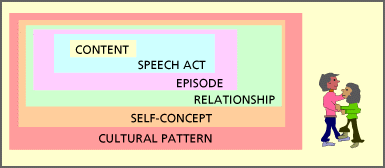

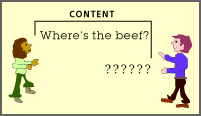 information, as signs, and as the paradigms and syntagms of
language appears in many of the theories presented in this tutorial. In
this case the content is a series of vocal sounds which the example
represents by the string of symbols: "Where's the beef?" It is
important to see that the content, by itself, is not sufficient to
establish
the meaning of the communication. All six levels of the model must work
together to do that.
information, as signs, and as the paradigms and syntagms of
language appears in many of the theories presented in this tutorial. In
this case the content is a series of vocal sounds which the example
represents by the string of symbols: "Where's the beef?" It is
important to see that the content, by itself, is not sufficient to
establish
the meaning of the communication. All six levels of the model must work
together to do that.
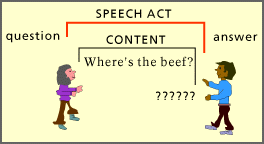 There are many different kinds of
illocutionary and perlocutionary acts -- questions, answers, commands,
promises, and so forht -- and the participants' knowledge of these plays a part in the communication.
The phrase "Where's the beef?" could be a question -- that is, the speaker
could be asking where she might find the beef, or it might be a statement --
that is, in response to the request "Name a famous fast food advertising slogan
from the 1980s" she might respond, "Where's the beef?"
There are many different kinds of
illocutionary and perlocutionary acts -- questions, answers, commands,
promises, and so forht -- and the participants' knowledge of these plays a part in the communication.
The phrase "Where's the beef?" could be a question -- that is, the speaker
could be asking where she might find the beef, or it might be a statement --
that is, in response to the request "Name a famous fast food advertising slogan
from the 1980s" she might respond, "Where's the beef?"
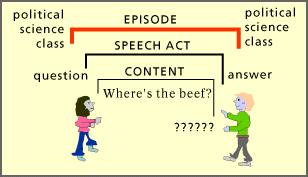
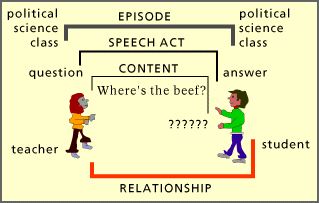
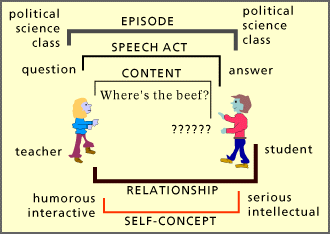
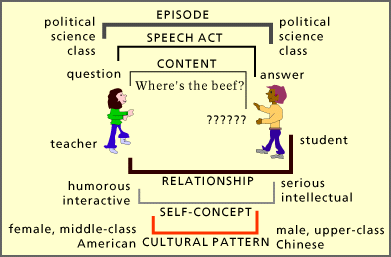
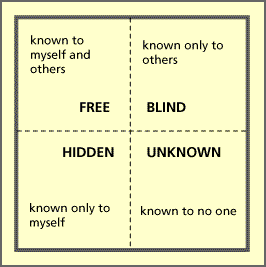 is known to him- or her-self
and to others.
is known to him- or her-self
and to others.
